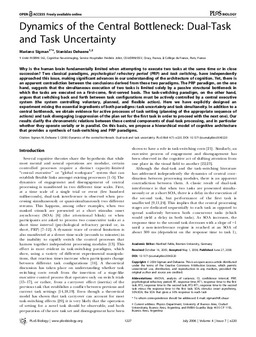| dc.rights.license | https://creativecommons.org/licenses/by/4.0/ | es_AR |
| dc.contributor.author | Sigman, Mariano | es_AR |
| dc.contributor.author | Dehaene, Stanislas | es_AR |
| dc.date.accessioned | 2018-08-18T17:30:23Z | |
| dc.date.available | 2018-08-18T17:30:23Z | |
| dc.date.issued | 2006-06-27 | |
| dc.identifier | doi: 10.1371/journal.pbio.0040220 | es_AR |
| dc.identifier.uri | https://doi.org/10.1371/journal.pbio.0040220 | es_AR |
| dc.identifier.uri | https://repositorio.utdt.edu/handle/20.500.13098/11088 | |
| dc.description.abstract | Why is the human brain fundamentally limited when attempting to execute two tasks at the same time or in close succession? Two classical paradigms, psychological refractory period (PRP) and task switching, have independently approached this issue, making significant advances in our understanding of the architecture of cognition. Yet, there is an apparent contradiction between the conclusions derived from these two paradigms. The PRP paradigm, on the one hand, suggests that the simultaneous execution of two tasks is limited solely by a passive structural bottleneck in which the tasks are executed on a first-come, first-served basis. The task-switching paradigm, on the other hand, argues that switching back and forth between task configurations must be actively controlled by a central executive system (the system controlling voluntary, planned, and flexible action). Here we have explicitly designed an experiment mixing the essential ingredients of both paradigms: task uncertainty and task simultaneity. In addition to a central bottleneck, we obtain evidence for active processes of task setting (planning of the appropriate sequence of actions) and task disengaging (suppression of the plan set for the first task in order to proceed with the next one). Our results clarify the chronometric relations between these central components of dual-task processing, and in particular whether they operate serially or in parallel. On this basis, we propose a hierarchical model of cognitive architecture that provides a synthesis of task-switching and PRP paradigms. | es_AR |
| dc.format.extent | 12 p. | es_AR |
| dc.format.medium | application/pdf | es_AR |
| dc.language | eng | es_AR |
| dc.relation.ispartof | PLoS Biology 4(7), (2008). ISSN: 1545-7885 | es_AR |
| dc.rights | info:eu-repo/semantics/openAccess | es_AR |
| dc.title | Dynamics of the central bottleneck : dual-task and task uncertainty | es_AR |
| dc.type | info:eu-repo/semantics/article | es_AR |
| dc.subject.keyword | Cognition | es_AR |
| dc.subject.keyword | Attention | es_AR |
| dc.subject.keyword | Decision making | es_AR |
| dc.subject.keyword | Fingers | es_AR |
| dc.subject.keyword | Experimental design | es_AR |
| dc.subject.keyword | Inertia | es_AR |
| dc.subject.keyword | Vision | es_AR |
| dc.subject.keyword | Analysis of variance | es_AR |
| dc.type.version | info:eu-repo/semantics/publishedVersion | es_AR |
| dc.description.filiation | Fil: Sigman, Mariano. Unité INSERM 562, Cognitive Neuroimaging, Service Hospitalier Frédéric Joliot, CEA/DRM/DSV, Orsay, France. | es_AR |
| dc.description.filiation | Fil: Dehaene, Stanislas. Unité INSERM 562, Cognitive Neuroimaging, Service Hospitalier Frédéric Joliot, CEA/DRM/DSV, Orsay, France. Collège de France, Paris, France | es_AR |

